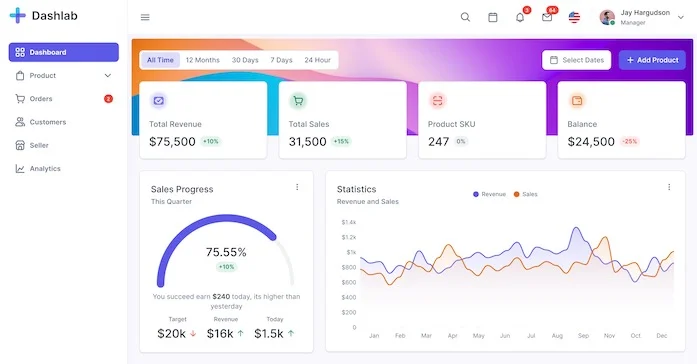Google may display different snippet lengths depending on the device and search query. However, the ideal length of a meta description is usually 150–160 characters or 920 pixels for desktop results. While on mobile is about 120 characters or 680 pixels.
Meta description length has a significant impact on your click-through rates and can make or break your search engine rankings.
In this article, we’ll dive into the nuts and bolts of meta descriptions. You’ll learn about Google’s guidelines for displaying snippets, the optimal character count for different devices, and strategies to craft compelling meta descriptions. We’ll also cover best practices to help you write meta descriptions that not only meet Google’s standards but also entice users to click through to your website.
What is a meta description?
A meta description is a brief summary of a webpage’s content that appears below the page title in search engine results pages (SERPs). It’s an HTML element typically found in the section of a webpage’s source code. The primary purpose of a meta description is to provide a concise overview of what users can expect to find when they click on the link.
Meta descriptions are usually limited to around 160 characters, though this can vary depending on the search engine and device used. They play a crucial role in attracting users to click on your page by offering a compelling preview of your content.
Why are meta descriptions important?
Meta descriptions have a significant impact on your website’s visibility and user engagement for some essential reasons:
- Improved click-through rates: A well-crafted meta description can entice users to click on your link, increasing your click-through rate (CTR) from search results.
- Enhanced user experience: By providing a clear summary of your page’s content, meta descriptions help users make informed decisions about which search results to explore.
- Brand awareness: Meta descriptions offer an opportunity to showcase your brand’s voice and unique selling points, even before users visit your site.
- Differentiation from competitors: A compelling meta description can help your page stand out among other search results, potentially attracting more clicks.
Google’s Meta Description Display Guidelines
Current length recommendations
While there’s no strict character limit, the recommended length to keep the meta descriptions aligned to Google standards is between 150 and 160 characters. This range allows for a concise summary of your page’s content without risking truncation in search results. You may use a tool like High Visibility to see how your meta description looks like in SERP.

How Google generates snippets
Google primarily uses the content on your page to automatically determine the appropriate snippet. This means that the visible text on your webpage is the main source for creating search result descriptions. Google’s algorithm analyses your content to find the most relevant and informative sections to display as snippets.
While meta descriptions are still considered, they’re not the primary source for snippets anymore. Google may use the meta description if it provides a more accurate summary of the page than the on-page content. This shift in Google’s approach emphasises the importance of having high-quality and relevant content throughout your entire webpage.
Factors affecting display length
Several factors influence the length of displayed snippets in search results:
- Device type: snippets may appear shorter on mobile devices compared to desktop searches.
- Search query: Google might show longer snippets for question-based searches or when it generates descriptions based on the search intent.
- Page content relevance: If your page content closely matches the search query, Google may display a longer snippet to provide more context.
- Screen width: Snippets are typically truncated to fit the user’s device screen width.
- Search result position: Top-ranking results might have slightly longer snippets compared to lower-ranking pages.
To optimise a meta description, focus on creating compelling, accurate summaries of your page content. Use relevant keywords naturally, and aim for clarity and conciseness. While you can’t control exactly how Google displays your snippets, providing high-quality descriptions increases the chances of your content being accurately represented in search results.
Best Practices for Writing Effective Meta Descriptions
Incorporating keywords
When crafting meta descriptions, it’s crucial to include the high intent keywords. Users often type specific phrases when searching, so incorporating these keywords can make your content more visible and appealing. For instance, if you’re targeting “best restaurant in Australia,” you might write: “Experience gastronomic delights at the best restaurant in Australia!” This approach effectively communicates the page’s relevance to the user’s search, increasing the likelihood of click-throughs.
However, avoid keyword stuffing. Google will automatically bold relevant search terms, so a description overflowing with keywords can appear confusing and unappealing. Instead, focus on creating a natural, engaging sentence that includes your target keyword organically.
Creating compelling content
Make your meta descriptions stand out, by using action-oriented language and focus on benefits. Tell readers what they’ll gain from clicking on your link. For example, instead of simply describing your product, highlight how it solves a problem or improves the user’s life.
Include a clear call-to-action (CTA) to encourage clicks. Phrases like “Discover,” “Experience,” or “Find out more” can be effective in prompting user action. Remember to write for people, not search engines. Use natural language that’s conversational and easy to understand.
Consider including specific details that set your page apart, such as product specifications, author information, or publication dates for blog posts. This additional information can make your description more informative and relevant to potential visitors.
Avoiding truncation
To ensure your meta description displays fully in search results, aim for a length between 150-160 characters. This range allows for a concise summary without risking truncation. Keep in mind that Google may display different snippet lengths depending on the device and search query.
For mobile devices, it’s best to keep descriptions around 120 characters. To accommodate both desktop and mobile users, place the most important information at the beginning of your description. This “front-loading” technique ensures critical details are visible even if the description gets cut off.
While character count is a useful guideline, pixel width is more accurate for determining display length. Aim for a width between 430-920 pixels to optimise visibility across various search engines.
Optimising Meta Descriptions for Different Devices
Desktop optimisation
When optimising meta descriptions for desktop devices, you have more space to work with. Desktop search results typically display up to 158 characters or 920 pixels. This gives you room to create more detailed descriptions that can include additional information about your page content. However, it’s crucial to front-load your meta descriptions with the most important information to ensure it’s visible even if the description gets truncated.
Focus on creating compelling, action-oriented content that includes relevant keywords naturally. Remember that Google will bold keywords that match the user’s search query, making your description more eye-catching in the search results.
Mobile considerations
Mobile devices present a unique challenge for meta descriptions due to their smaller screen size. On mobile, meta descriptions are usually limited to about 120 characters or 680 pixels. This means you need to be even more concise and to the point with your descriptions.
When crafting meta descriptions for mobile, prioritise the most critical information and place it at the beginning of the description. This ensures that users can quickly understand what your page offers, even if the full description isn’t visible. Consider using shorter words and phrases to maximise the information you can convey within the limited space.
Responsive design best practices
To accommodate both desktop and mobile users, it’s essential to implement responsive design practices for your meta descriptions. Here are some tips to optimise your descriptions across devices:
- Use a flexible pixel width: Aim for a meta description length between 430 pixels (minimum) and 920 pixels (maximum). This range generally translates to about 70-155 characters and works well across various search engines and devices.
- Create different tags: Consider creating separate meta descriptions for desktop and mobile. This allows you to tailor your content to the specific search patterns and expectations of users on different devices.
- Focus on readability: Ensure your meta descriptions are easy to read on smaller screens. Break up longer phrases and use concise language to improve clarity.
- Test your descriptions: Use tools to preview how your meta descriptions appear on different devices. This helps you identify any issues with truncation or readability before your content goes live.
Optimising your meta descriptions for both desktop and mobile devices can improve your click-through rates and provide a better user experience across all platforms.
How to write compelling and effective meta descriptions
1. Incorporate targeted keywords
To create meta descriptions that resonate with search engines and users alike, it’s crucial to incorporate your target keywords naturally. When crafting your description, focus on including the primary keyword or keyphrase you want to rank for. This practice helps search engines understand your page’s content and increases the likelihood of your description appearing in search results.
However, avoid keyword stuffing, as it can make your description appear unnatural and may deter users from clicking. Instead, aim to weave your keywords into a compelling narrative that accurately summarises your page’s content.
2. Creating unique descriptions for each page
Maximise the impact of your meta descriptions. It’s essential to create unique content for each page on your website. Duplicate content or descriptions across multiple pages can confuse search engines and users, potentially harming your search rankings and click-through rates.
When writing descriptions, focus on summarising the specific content of each page. Highlight the unique value proposition or key information that sets that particular page apart. For example, product pages might include details like price, manufacturer, or special features, while blog posts could mention the author, publication date, or main topic.
3, A/B testing meta descriptions
Optimise your meta descriptions further, consider implementing A/B testing. This process involves creating two versions of a description and comparing their performance to determine which one resonates better with your audience.
When conducting A/B tests, focus on variables such as different calls-to-action, varying lengths, or alternative ways of presenting your key information. Use tools like Google Search Console to track click-through rates and rankings for each version. This data-driven approach can provide valuable insights into user preferences and help you refine your meta description strategy over time.
Optimise your page meta description with impact
Crafting effective meta descriptions has a significant impact on your website’s visibility and user engagement. By sticking to the ideal length of 150-160 characters for desktop and about 120 characters for mobile, you can create compelling summaries that grab attention in search results. Remember to include relevant keywords, highlight unique selling points, and use action-oriented language to entice clicks.
Make the most of your meta descriptions, it’s crucial to tailor them to different devices and continuously refine your approach. Ultimately, well-crafted meta descriptions serve as powerful tools to attract potential visitors and showcase the value of your content.






